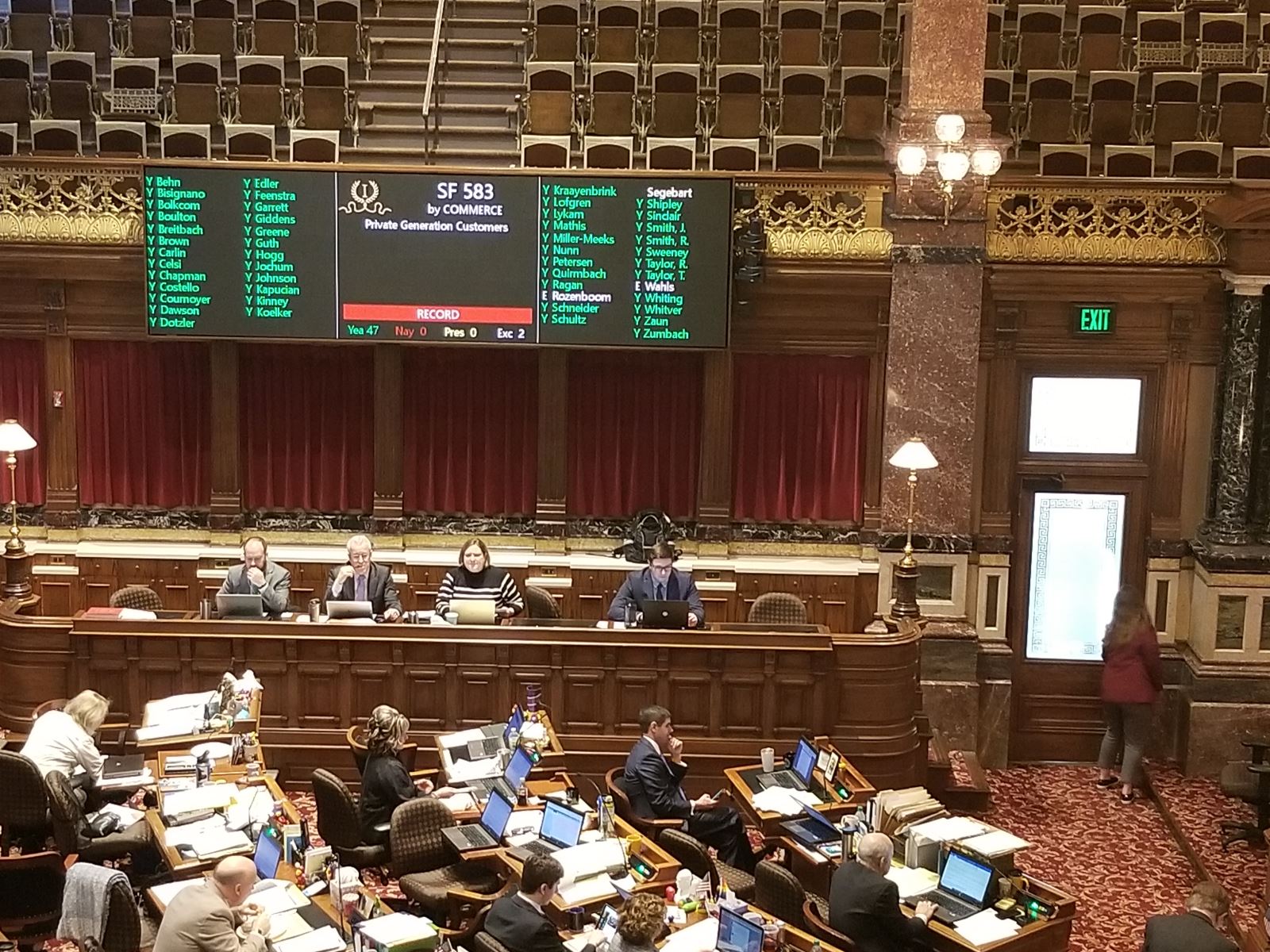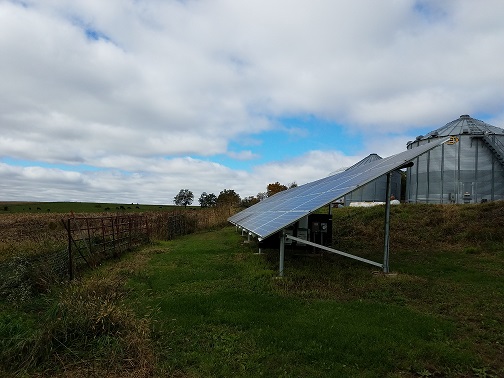New Iowa Law Keeps Solar Growing
posted
by Kerri Johannsen on Thursday, April 2, 2020

On March 12, 2020, Governor Reynolds signed SF 583 – a bill IEC and our partners had dubbed the “Sunshine Tax” that failed a year earlier. In the course of that year, Senate File 583 evolved into something that is rarely achieved: legislation with unanimous support from both political parties in both houses of the legislature.
It is a new policy that takes the best of ideas from other states and puts them together to create a policy that found support among solar businesses, environmental groups, farm groups, and MidAmerican Energy with no outspoken opposition by any other party.
The Iowa Environmental Council played a key role in researching and formulating policy options, analyzing the impacts of various scenarios, and negotiating the specific legal language that would get the results we were looking for. Our strong partnerships with the Environmental Law and Policy Center (ELPC), the Iowa Solar Energy Trade Association (ISETA), and the Iowa Pork Producers (IPP) helped deliver this win for solar in Iowa.

We are excited about the long-term potential for this law to open up and stabilize the market for solar in the areas of Iowa served by MidAmerican and Alliant Energy. The new law officially takes effect on July 1, 2020. We expect the utilities to make filings at the Iowa Utilities Board to implement the new rates and policies prior to that date, and we will be evaluating and weighing in on any implementation filings at the Board. Check out our full summary of the bill below.
Summary of Iowa Solar Bill
Senate File 583 puts net metering into Iowa law for the first time, while creating a new, optional inflow-outflow billing system for customer-owned generation like solar. Each utility will choose whether to offer net billing (similar to the current net metering) or an inflow-outflow billing method to all customers installing new generation. Current net metering customers will be grandfathered and remain on their current rate structure. New net metering solar customers will be allowed to supply their own energy needs under either the net billing or the new inflow-outflow billing.
New net billing
- Any kWh imported from the utility by the customer will be paid for by the customer at the retail rate.
- Any kWh exported to the grid will be credited to the customer as a kWh credit that covers the full kWh rate.
- Kilowatt-hour credits will be credited monthly to offset the customer’s monthly use.
- Kilowatt-hour credit balances can be carried forward for up to 12 months and a customer can choose either a January or April cash out date.
- Kilowatt-hour credit balances remaining at the end of the 12-month period will be cashed out at the utility avoided cost rate with one-half credited to the customer and one-half going to the utility low-income home energy assistance program (LIHEAP).
New Inflow/Outflow billing
- Any kWh imported from the utility by the customer (inflow) will be paid for by the customer at the retail rate.
- Any kWh exported to the grid (outflow) will be credited to the customer at the outflow rate.
- Outflow credits will be credited monthly as dollar amounts to offset the customer’s monthly bill, not including any fixed charges like the monthly meter charge.
- Credit balances can be carried forward for up to 12 months and a customer can choose either a January or April cash-out date.
- Credit balances remaining at the end of the 12-month period will be forfeited to the utility and used to offset collections under the rider mechanism to lower costs for all customers.
- The utility is allowed to recover the amount it credits to customers for outflow through a rider on all customer bills, similar to how the utility collects money for other types of energy purchases.
Outflow rate
- The outflow rate will initially be set at the applicable retail rate for the rate class so inflow-outflow will be the same as net metering from a payback/economic perspective for the customer.
- A Value of Solar (VOS) study is triggered when customer-owned solar penetration in the Alliant and MidAmerican service territories combined reaches 5% of total peak demand for the two utilities (determined annually by the Iowa Utilities Board) or after 7 years, whichever is sooner. We have calculated that Iowa is currently at about 1% penetration.
- A customer installing a system receives a locked-in outflow rate for 20 years that would be set:
- Equal to the applicable retail rate prior to VOS implementation; and
- At the current VOS rate after VOS implementation.
Value of Solar
- The Value of Solar methodology will be created through a stakeholder process overseen by the Iowa Utilities Board and utilizing an independent third party consultant. The primary inputs for the VOS Study are set in the law and based on those included in the Minnesota VOS.
- The VOS rate will be unique to each utility based on their specific inputs. The outflow rate that will be paid to new solar installs for that year will be updated annually and the overall methodology for the VOS updated every three years.
- The law specifies that the VOS rate shall not fluctuate by more than 5% annually.
Net metering protections
- The bill provides certainty for net metering customers on policy for both net billing and inflow-outflow billing customers. New policies for both billing structures include prohibitions on:
- Using customer demand instead of energy use to limit system size
- Charging solar customers fees that are not charged to other customers
- Placing solar customers in a separate rate class. (This protection expires upon adoption of a VOS or 7 years, whichever comes sooner. At that time, it will be within the purview of the IUB to decide whether separate rate classes are appropriate if a utility makes such a request as part of a rate case.)
- The bill also specifies that the net metering credits, under either net billing or inflow/outflow billing, cover all volumetric charges including any riders charged on a kWh basis.
Use of Utility Green Energy Purchase Funds
The utilities would be permitted to use their own clean energy fund (comprised of voluntary customer contributions) to cover the costs of outflow payments to solar customers and avoid collection of these costs through the rider.
Watch for more information as the utilities file new policies with the Iowa Utilities Board.
- clean energy
- iowa legislature
- renewable energy
- solar power